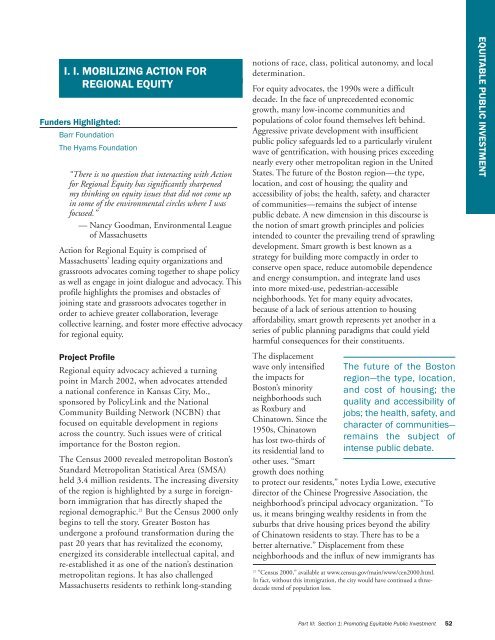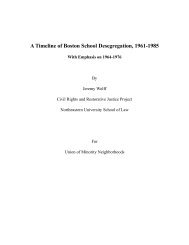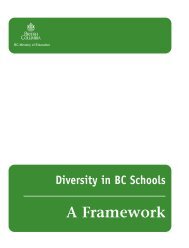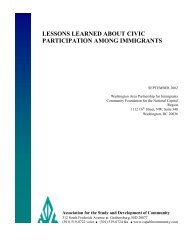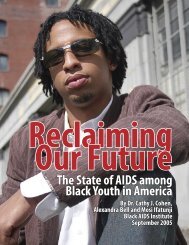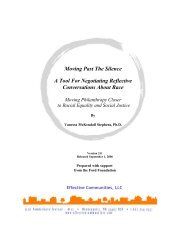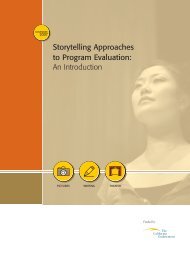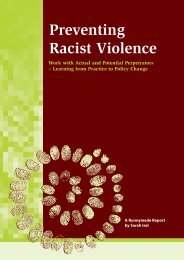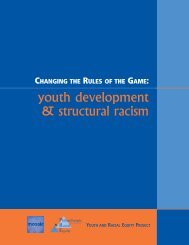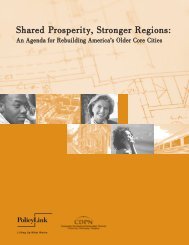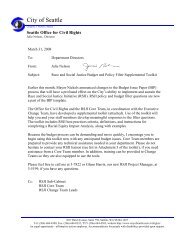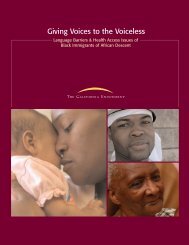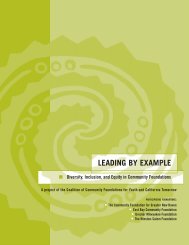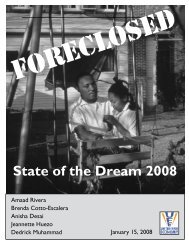Stories of Philanthropic Leadership in Advancing Regional and ...
Stories of Philanthropic Leadership in Advancing Regional and ...
Stories of Philanthropic Leadership in Advancing Regional and ...
Create successful ePaper yourself
Turn your PDF publications into a flip-book with our unique Google optimized e-Paper software.
I. I. MOBILIZING ACTION FORREGIONAL EQUITYFunders Highlighted:Barr FoundationThe Hyams Foundation“There is no question that <strong>in</strong>teract<strong>in</strong>g with Actionfor <strong>Regional</strong> Equity has significantly sharpenedmy th<strong>in</strong>k<strong>in</strong>g on equity issues that did not come up<strong>in</strong> some <strong>of</strong> the environmental circles where I wasfocused.”— Nancy Goodman, Environmental League<strong>of</strong> MassachusettsAction for <strong>Regional</strong> Equity is comprised <strong>of</strong>Massachusetts’ lead<strong>in</strong>g equity organizations <strong>and</strong>grassroots advocates com<strong>in</strong>g together to shape policyas well as engage <strong>in</strong> jo<strong>in</strong>t dialogue <strong>and</strong> advocacy. Thispr<strong>of</strong>ile highlights the promises <strong>and</strong> obstacles <strong>of</strong>jo<strong>in</strong><strong>in</strong>g state <strong>and</strong> grassroots advocates together <strong>in</strong>order to achieve greater collaboration, leveragecollective learn<strong>in</strong>g, <strong>and</strong> foster more effective advocacyfor regional equity.Project Pr<strong>of</strong>ile<strong>Regional</strong> equity advocacy achieved a turn<strong>in</strong>gpo<strong>in</strong>t <strong>in</strong> March 2002, when advocates attendeda national conference <strong>in</strong> Kansas City, Mo.,sponsored by PolicyL<strong>in</strong>k <strong>and</strong> the NationalCommunity Build<strong>in</strong>g Network (NCBN) thatfocused on equitable development <strong>in</strong> regionsacross the country. Such issues were <strong>of</strong> criticalimportance for the Boston region.The Census 2000 revealed metropolitan Boston’sSt<strong>and</strong>ard Metropolitan Statistical Area (SMSA)held 3.4 million residents. The <strong>in</strong>creas<strong>in</strong>g diversity<strong>of</strong> the region is highlighted by a surge <strong>in</strong> foreignbornimmigration that has directly shaped theregional demographic. 21 But the Census 2000 onlybeg<strong>in</strong>s to tell the story. Greater Boston hasundergone a pr<strong>of</strong>ound transformation dur<strong>in</strong>g thepast 20 years that has revitalized the economy,energized its considerable <strong>in</strong>tellectual capital, <strong>and</strong>re-established it as one <strong>of</strong> the nation’s dest<strong>in</strong>ationmetropolitan regions. It has also challengedMassachusetts residents to reth<strong>in</strong>k long-st<strong>and</strong><strong>in</strong>gnotions <strong>of</strong> race, class, political autonomy, <strong>and</strong> localdeterm<strong>in</strong>ation.For equity advocates, the 1990s were a difficultdecade. In the face <strong>of</strong> unprecedented economicgrowth, many low-<strong>in</strong>come communities <strong>and</strong>populations <strong>of</strong> color found themselves left beh<strong>in</strong>d.Aggressive private development with <strong>in</strong>sufficientpublic policy safeguards led to a particularly virulentwave <strong>of</strong> gentrification, with hous<strong>in</strong>g prices exceed<strong>in</strong>gnearly every other metropolitan region <strong>in</strong> the UnitedStates. The future <strong>of</strong> the Boston region—the type,location, <strong>and</strong> cost <strong>of</strong> hous<strong>in</strong>g; the quality <strong>and</strong>accessibility <strong>of</strong> jobs; the health, safety, <strong>and</strong> character<strong>of</strong> communities—rema<strong>in</strong>s the subject <strong>of</strong> <strong>in</strong>tensepublic debate. A new dimension <strong>in</strong> this discourse isthe notion <strong>of</strong> smart growth pr<strong>in</strong>ciples <strong>and</strong> policies<strong>in</strong>tended to counter the prevail<strong>in</strong>g trend <strong>of</strong> sprawl<strong>in</strong>gdevelopment. Smart growth is best known as astrategy for build<strong>in</strong>g more compactly <strong>in</strong> order toconserve open space, reduce automobile dependence<strong>and</strong> energy consumption, <strong>and</strong> <strong>in</strong>tegrate l<strong>and</strong> uses<strong>in</strong>to more mixed-use, pedestrian-accessibleneighborhoods. Yet for many equity advocates,because <strong>of</strong> a lack <strong>of</strong> serious attention to hous<strong>in</strong>gaffordability, smart growth represents yet another <strong>in</strong> aseries <strong>of</strong> public plann<strong>in</strong>g paradigms that could yieldharmful consequences for their constituents.The displacementwave only <strong>in</strong>tensifiedthe impacts forBoston’s m<strong>in</strong>orityneighborhoods suchas Roxbury <strong>and</strong>Ch<strong>in</strong>atown. S<strong>in</strong>ce the1950s, Ch<strong>in</strong>atownhas lost two-thirds <strong>of</strong>its residential l<strong>and</strong> toother uses. “Smartgrowth does noth<strong>in</strong>gThe future <strong>of</strong> the Bostonregion—the type, location,<strong>and</strong> cost <strong>of</strong> hous<strong>in</strong>g; thequality <strong>and</strong> accessibility <strong>of</strong>jobs; the health, safety, <strong>and</strong>character <strong>of</strong> communities—rema<strong>in</strong>s the subject <strong>of</strong><strong>in</strong>tense public debate.to protect our residents,” notes Lydia Lowe, executivedirector <strong>of</strong> the Ch<strong>in</strong>ese Progressive Association, theneighborhood’s pr<strong>in</strong>cipal advocacy organization. “Tous, it means br<strong>in</strong>g<strong>in</strong>g wealthy residents <strong>in</strong> from thesuburbs that drive hous<strong>in</strong>g prices beyond the ability<strong>of</strong> Ch<strong>in</strong>atown residents to stay. There has to be abetter alternative.” Displacement from theseneighborhoods <strong>and</strong> the <strong>in</strong>flux <strong>of</strong> new immigrants has21“Census 2000,” available at www.census.gov/ma<strong>in</strong>/www/cen2000.html.In fact, without this immigration, the city would have cont<strong>in</strong>ued a threedecadetrend <strong>of</strong> population loss.EQUITABLE PUBLIC INVESTMENTPart III: Section 1: Promot<strong>in</strong>g Equitable Public Investment 52


